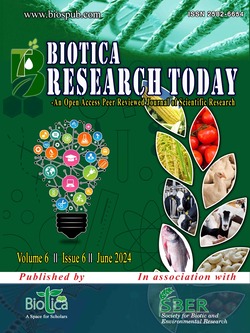
Fusion Proteins as a Resistance Factor against Insect Pests
Marri Keerthana*
Dept. of Entomology, PG College of Agriculture, Dr. Rajendra Prasad Central Agricultural University, Pusa, Samastipur, Bihar (848 125), India
Arindam Pal
Dept. of Entomology, PG College of Agriculture, Dr. Rajendra Prasad Central Agricultural University, Pusa, Samastipur, Bihar (848 125), India
M.S. Sai Reddy
Dept. of Entomology, PG College of Agriculture, Dr. Rajendra Prasad Central Agricultural University, Pusa, Samastipur, Bihar (848 125), India
DOI: NIL
Keywords: Fusion proteins, Insect-resistant crops, Insecticidal proteins, Resistance
Abstract
The development of insect-resistant crops has been a significant challenge in agriculture. Fusion proteins technology, a promising approach, combines the properties of different proteins to confer resistance against insect pests. These fusion proteins are engineered by fusing genes from different sources, such as Bacillus thuringiensis (Bt), scorpion toxin-based, spider venom-based and other insecticidal proteins. The resulting fusion proteins exhibit enhanced insecticidal activity, broader insect target range and improved stability compared to individual proteins. Moreover, they can overcome the development of resistance in insect populations, a major concern with conventional insect-resistant crops. Fusion proteins have shown promising results in various crop systems against lepidopteran, coleopteran and hemipteran pests. However, optimizing their expression, stability and bio-safety requires further research for sustainable insect pest management.
Downloads
not found
Reference
Fernández, R.M., Petek, M., Gerasymenko, I., Juteršek, M., Baebler, S., Kallam, K., Giménez, E.M., Gondolf, J., Nordmann, A., Gruden, K., Orzaez, D., Patron, N.J., 2021. Insect pest management in the age of synthetic biology. Plant Biotechnology Journal 20(1), 25-36. DOI: https://doi.org/10.1111/pbi.13685.
Fitches, E., Edwards, M.G., Mee, C., Grishin, E., Gatehouse, A.M.R., Edwards, J.P., Gatehouse, J.A., 2004. Fusion proteins containing insect-specific toxins as pest control agents: Snowdrop lectin delivers fused insecticidal spider venom toxin to insect haemolymph following oral ingestion. Journal of Insect Physiology 50(1), 61-71. DOI: https://doi.org/10.1016/j.jinsphys.2003.09.010.
van Dijk, M., Morley, T., Rau, M.L., Saghai, Y., 2021. A meta analysis of projected global food demand and population at risk of hunger for the period 2010-2050. Nature Food 2, 494-501. DOI: https://doi.org/10.1038/s43016-021-00322-9.
Zsögön, A., Peres, L.E.P., Xiao, Y., Yan, J., Fernie, A.R., 2022. Enhancing crop diversity for food security in the face of climate uncertainty. The Plant Journal 109(2), 402-414. DOI: https://doi.org/10.1111/tpj.15626.
